Blue is one of the most sought-after colors when it comes to gemstones. Don’t believe me? Take a look around a jewelry store or gem show and you’ll notice most of the stones are a shade of blue and red will be a close second.
From beautiful, bold, fresh colors to deep blue hues, blue crystals, and gemstones are incredibly calming.
Before we start discussing types and varieties of blue crystals we should take a minute and talk about the color blue. I know this sounds boring but it is important if you’re a buyer or collector. Pure blue is going to be the most valuable, but secondary colors can be present.
Secondary hues in blue stones are purple and green depending on the mineral.
Types of Blue Crystals
Blue hues reach top intensity or saturation at medium-dark tones. This is called the Gamut Limit.
Vivid saturation produces dazzling blue colors which almost glow when you see them in person. Darker tones appear steely or inky, while lighter shades might appear washed out or gray. Regardless, beautiful blue crystals are available in a wide range of tones, from light and sky blues to deep, rich, dark colors.
Generally, a pure blue color is the most desirable and expensive but it’s hard to come by. As you scroll through the content and pics you’ll notice most stones have secondary colors and the gemstones with a pure blue color will attract your attention the most.
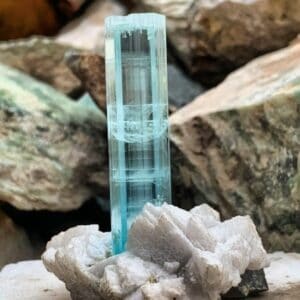
Aquamarine
Aquamarine crystals are often light in tone, ranging from greenish-blue to blue-green but everyone is looking for the Santa Maria color or darker. Most of the material is mined in Brazil but is also found in Madagascar, Nigeria, Pakistan, Zambia, and Mozambique.
This is one that is always in my top 10 best gemstone list because no matter the shade of blue the crystals and finished gemstone always turn out amazing.
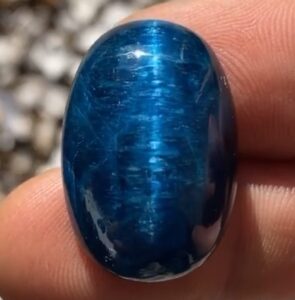
Apatite
Apatite crystals are somewhat rare but you can find material at your local gem show. They come in an array of colors but the blue really stands out when you see them in person. As you can see from the cat’s eye cabochon above, Apatite is a must-have for any collection.
These beautiful blue stones come from Madagascar and Brazil and come in almost every shade of blue, from neon blue to bright indigo and royal blues.

Chrysocolla
Chrysocolla crystals have a cyan (bluish-green) color and are derived from ore of copper. This material is almost always cut into cabochons but you will see specimens from time to time. As you can see from the photo, this material can be very eye-catching if cut correctly.
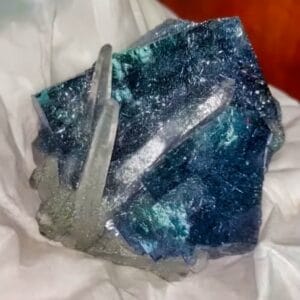
Fluorite
Fluorite’s vitreous luster and translucent quality are what make it a favorite among collectors. These crystals occur in all shades of blue, from light sky blues to deep navy blue. When looking at this material you’ll come across two different types. The first type will have banding inside the stone with clear sections and blue-colored sections. The other type will be in crystal form like the one above.
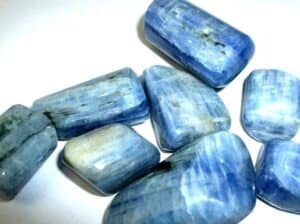
Kyanite
Kyanite is fairly unique because it has two cleavage planes and high-quality material is amazing to look at but it’s hard to find. Typically, this aluminum silicate mineral is a patchy blue in color and the crystals form in wafers.
If you can find the deep blue material in specimen form then I’d recommend adding one to your collection.

Amazonite
Amazonite generally ranges from light green to greenish blue or bluish green and comes in large chunks or crystal form. The best material is in crystal form with Smoky Quartz crystals attached to make it a highly prized specimen. The chunky material is fashioned into beads, cabochons, and decorative items.
Amazonite has been found at several archeological sites in the Middle East, dating back 2,000 years.

Blue Calcite
I decided to add Blue Calcite to the list because it’s on the more affordable side if you’re looking to start a gem and mineral collection. The shades of Blue Calcite can vary, ranging from light blue to bright blue. These crystals can also be blue with shades of gray.
The main component of these stones is calcium carbonate, along with an addition of other minerals.
Dark Blue Crystals
A dark blue crystal with high saturation will bring the highest value because they’re the rarest. If you already have a nice collection of blue crystals then you might want to consider some darker blue crystal varieties to add to the collection along the way.
Don’t go too dark, unless you’re looking at Azurite because the crystals will look black and won’t represent the rich blue color inside.
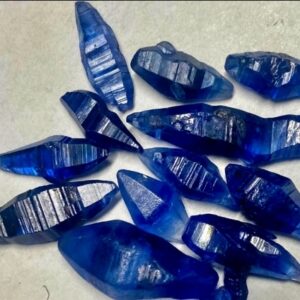
Sapphire
For Sapphire to be called blue, its secondary colors can not have more than 15 percent of its color. You see this issue with “parti” Sapphires from Australia. They have a rich blue color but it is shared with greens and yellows.
Sapphires with secondary colors in larger quantities would be classified as unique or fancy-colored Sapphires.

Lapis Lazuli
Lapis Lazuli has an indigo, marine, or midnight blue color and makes for great cabochons and jewelry. However, the signature hue of this stone is a slightly dark blue to violet-blue, that are medium to dark in tone and highly saturated. The most prized forms of Lapis Lazuli have no visible calcite, but they might have gold-colored Pyrite flecks.

Dumortierite
Like many crystals, Dumortierite is available in a range of colors. Typically, this stone ranges from deep blue hues to a soft lilac color, often with many clear or white Quartz crystals throughout the matrix. However, some Dumortierites come in earthy shades, featuring brown or pink hues.
The best example of this mineral is when it is an inclusion inside of Quartz crystals. Take a look above and you’ll see why. These crystals are highly collectible and demand a premium.
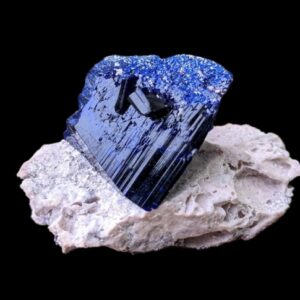
Azurite
Azurite is a natural carbonate of copper that’s usually described as a bright blue and sometimes greenish-blue. It varies in mass, tone, and color from deep dark blue to pale blue with greenish undertones. The shades of this stone depend on factors like the purity of the minerals and the grade or particle size of the pigment.
If you have the money, then you want to focus on the crystallized specimens. Those are the most sought-after.

Afghanite
Afghanite is a rare mineral with an incredible blue color. I have to admit, I’ve never seen one of these crystals before but they do like interesting. These stones have a relatively close resemblance to Lazurite, and they occur together in the same deposits. These crystals are named after the most significant locality in northern Afghanistan.
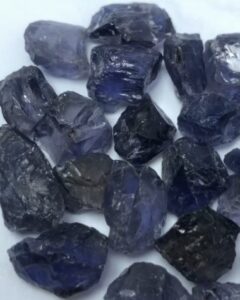
Iolite
According to some legends, ancient Viking navigators once used thin slices of Iolite as filters that helped them locate the sun on cloudy days. However, there may or may not be truth in these tales.
Iolite can display blue to violet hues in one direction with pale yellow to colorless shades in another.

Blue Sodalite
Blue Sodalite will always display veins with white markings or streaks. The ideal color of these stones is intense blue but it tends to be blotchy.
It comes in all shades of blue, ranging from light blue to royal blue and from grayish blue to violet. Different shades of blue are often present in a single stone.
One thing to note about Sodalite is its ability to fluoresce under UV light.
Blue and Dark Blue Crystal Types
The list of blue crystals is actually quite lengthy because most gems and minerals have a blue variety but that doesn’t necessarily make them collectable.
If you’re a fan of only collecting crystals then you’ll have plenty of shades of blue to pick from. Of course, some of the crystals on this list can be found in various colors outside the spectrum of blue as well.
- Identify Enstatite - March 12, 2024
- Identify Cerussite - March 3, 2024
- Identify Bytownite - February 18, 2024
